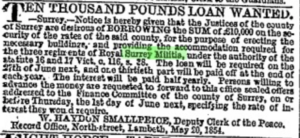Place Name
Named after the barracks of the 1st Surrey Militia that stood near here. On Thursday, May 25, 1854, an advert appeared in The Times placed by the Justices of the County of Surrey seeking a 30 year loan of £10,000 on security of the rates for the purpose of “erecting the necessary buildings and providing the accommodation required for the three regiments of Royal Surrey Militia”. But by November 1857, with the militia raised, the barracks had still not been completed. Instead, as was the custom, they were billeted in local hotels and houses to the chagrin of the local residents. By December 15, one hotelier had had enough, writing on behalf of the licensed victuallers he complained to The Times that they were “protesting against the gross injustice inflicted on us by the Militia being billeted here for so lengthened a period, more especially as there is such a place as the camp at Aldershott. The anonymous writer explained: “The 1st Royal Surrey Militia has been quartered here for about six weeks, and the billets extend to a fortnight longer. It is only necessary to say that 99 officers and men are billeted on two houses alone – viz., the Star and Garter, 50 men and six officers, and the Castle Hotel, 39 men and four officers – other houses in proportion. To show the very great expense and inconvenience we are subjected to, I may further state that the annoyance is not confined to the licensed victuallers only, the inhabitants generally feel the inconvenience and detriment, as Richmond is a place whose prosperity entirely depends upon visitors, and the presence of 800 young men, many of whom are disorderly and dissolute, converts it from the quiet attractive town it usually is to ill-disciplined barracks. I should inform you that a letter has been addressed to his Royal Highness the Duke of Cambridge on the subject, to which has been returned a most gracious reply, promising that the Militia shall be removed at the earliest possible opportunity; but even that will only afford a temporary relief, whereas it is our desire to obtain a permanent one. We cannot, of course, complain of marching regiments being temporarily quartered upon us, but we protest against the Militias infliction for so lengthy a period as above stated, and we sincerely trust by your kindly inserting this letter it may attract the attention of our county members, and that they will next session bring it before Parliament, and obtain for us a removal of the existing evil.” The building called Castlegate was eventually finished “with a facade like a medieval fortress”. In theory the Militia should have been a voluntary army, but men could be conscripted by ballot if the militia fell short of its quota. Unlike the standing army, this force was only called out in times of crisis when the regular army was away, which it was which it was during the Crimea War of 1854 and again a few years later during the Indian Mutiny of 1857. By 1859 the numbers of volunteers had dwindled to under 40 men, The Times reporting that they had been “drilling twice a week (Wednesdays and Saturdays) at the Staff House of the 1st Royal Surrey Militia”. The paper added that: “Though at present only a sub division, there is every reason to hope that its numbers will soon be sufficiently increased ro form a full company.” When the soldiers moved to Kingston sometime around 1876, the medieval fortress style building was used as tenements, eventually being cleared away in 1909 when the area was used for allotments. By 1923 the area was developed for housing off the newly created St Paul’s Road.
![]()
